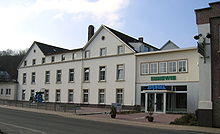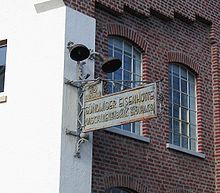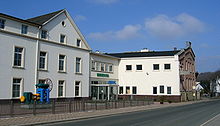Andritz Sundwig
The Andritz Sundwig GmbH (formerly Sundwiger ironworks ) is a German plant -Unternehmen based in Hemer , Germany .
The majority of Andritz Sundwig has belonged to the Austrian plant engineering group Andritz AG since January 1998 . Here Andritz Sundwig belongs to the Andritz Metals division (formerly “Rolling and Strip Processing Lines”). Together with other companies in the Andritz Group, the company produces complete systems and components for hot and cold rolling, pickling and annealing of stainless steel, coated strip and non-ferrous metals. The main markets are Central Europe, China, Russia and India.
Andritz Sundwig employs more than 400 people at its location in Sundwig . There is also a second location in Lahr in the Black Forest .
History of the company
The beginnings
The main factory of Andritz Sundwig is located on the site of one of the oldest iron smelters in the Sauerland in Brandenburg . When the Iserlohn / Altena / Lüdenscheid area developed into one of the first industrial areas over the centuries , the Sundwiger ironworks was around 1800 and for a long time afterwards the only steelworks in the Brandenburg district and also the only company in which iron production, processing and for Part also -sale in one hand.
The Iserlohn factory owner Johann Bernhard von der Becke (1655–1730) founded the company at the end of the 17th century. Local history mentions that in 1690 he was the first to introduce the manufacture of iron buckles and clasps in Iserlohn. But when he started to break a privilege granted by the city of Nuremberg and manufacture thimbles and sewing rings, he came into conflict with the authorities. The Iserlohn Council forced him to stop production in 1696. Johann Bernhard von der Becke then acquired a property outside the Iserlohn city area in Sundwig, on the site of which there was also a derelict hammer mill. In 1698, von der Becke began producing iron in a new hammer mill with a melting furnace and processing it into buckles and clasps. At the same time he pursued the plan to take over the process of producing thimbles according to the Dutch or English model, which is not privileged in Germany. This finally succeeded in 1712 after his son Johann Dietrich von der Becke had explored the technology in the Netherlands. In the same year, after the last big fire in Iserlohn, Johann Bernhard von der Becke moved to Sundwig and increased his property there. From that moment until shortly after the First World War, Sundwig's industrial development remained associated with the von der Becke name .
For the history of the ironworks, the fact that the founding family also switched to adopting the brass foundry process that was brought from Cleve to Iserlohn after 1716 was significant. For this purpose, Johann Dietrich von der Becke set up a brass smelter on Sundwiger Bach, from which the Sundwiger brass works developed over the decades .
In 1736, when the Iserlohn Brass Company was founded in Iserlohn under the leadership of Mayor Johann Caspar Lecke , the local calamine was smelted on site for the first time and fused with copper to form brass. Johann Dietrich von der Becke also participated in this company on behalf of his sons. According to the family's records, it was financed from the proceeds of iron processing during the start-up period.
But an important decision was also made in the ironworks sector at this time. In accordance with the mercantilist efforts of the Prussian government to smelt domestic iron ores such as those from the Felsenmeer in the country, Johann Dietrich von der Becke participated in the establishment of a union to exploit the Felsenmeer and to build and operate a blast furnace . This blast furnace was built in 1739. Its soft, fine-grained iron was in great demand and formed an excellent basis for the clasp factory and thimble mill, which Johann Dietrich von der Becke continued to operate. At that time, Johann Heinrich von der Becke would head the ironworks. Heinrich and his brother Johann Adolph took over their father's businesses in 1758 and, as the brass works wrote in an anniversary publication from 1948, ran them in seldom harmony until their death.
At that time all hammer mills, whether they worked iron or brass, were in full operation. Each of the brothers worked under their own name and participated in other ventures, but brought the proceeds into a common fund.
With their help it was also possible to bridge the failures that arose in the course of the Seven Years' War (1756–1763) with varying effects in the individual branches of production. Old business books show that the business assets of the iron processing plants of von der Beckes tripled between 1782 and 1792. From 1798 the brass works and ironworks were practically separated from each other.
19th century
Only indirectly affected by the Napoleonic wars , English industry had made enormous progress and gained a considerable head start by using steam power with undisturbed technical development. The struggle for existence of the Iserlohn needle industry belongs in this chapter. In Sundwig they responded to the challenge with the construction of a new, charcoal-fired, 12 meter high blast furnace, which - admired by contemporaries as an "imposing masterpiece" - was put into service in 1823. In the same year, the first iron mold casting in the Westphalian economic sector was carried out in the expanded plant . Old reports cite cooking pots, charcoal boxes and the so-called jug stoves as Sundwig cast products of that time. The iron produced in Sundwig from Felsenmeer ores had a good reputation and was forged into coveted bar iron in the hammer mills.
With the introduction of the English puddling process using hard coal , all kinds of charcoal- fired blast furnaces gradually became uneconomical. In the commercial address book of Julius Bädeker's Arnsberg district, which appeared in 1858, only the “Sundwig Ironworks Union” with a blast furnace is listed under “Iron and steel works” in the area of today's Märkische Kreis. Under "plant and peculiar products" it says: iron foundry from cupola furnace . In the entire administrative district of Arnsberg, including the Ruhr area, there were 56 blast furnaces at that time. The ones closest to Sundwig were in Wocklum , Haspe and Hörde .
From the middle of the 19th century onwards, the ironworks' difficulties increased. The machine production of wire nails was successful in 1859 , but these nails soon became unprofitable as cheap mass-produced articles. The surplus from the flourishing brass works had to support the ironworks (in reverse of the situation in 1736). In this situation Adolf von der Becke the Elder made a decisive decision in terms of factory history. In 1864, when the first steam engine in the Iserlohn area was put into operation by Stefan Witte in Iserlohn, he took over the ironworks in sole ownership, shut down the blast furnace after a year of processing the ore reserves and began building and setting up a foundry and machine shop in 1866. The first 30 hp steam engine was built just a year later.
In addition, wire drawing machines and parts for paper machines, mills and agricultural machines were also initially manufactured, although not with resounding success. The decisive factor for the further development of the company, however, was the decision to dedicate itself to the production of what was still a revolutionary propulsion system, the steam engine. The machines produced in the Sauerland were exported, for example to Russia to the Moscow Kremlin and the Petersburg Opera .
Sundwiger Eisenhütte also took part in the economic upswing that was accompanied by crises after the establishment of the German Empire in 1871. Production of larger piston steam engines was already started during the Franco-Prussian War , and drawing benches for wire drawing mills as well as equipment for wire weaving mills and wire pin factories were manufactured. At the large industrial and commercial exhibition in Düsseldorf in 1878, at the beginning of a general economic upswing, the company, which at that time still operated as Maschinenfabrik Adolf von der Becke, showed a steam engine with a cylinder diameter of 300 mm and a stroke of 600 mm, as well as three wire-pin machines.
With the beginning of the 1880s, especially after the invention of the universal rolling process in Hörde in 1848, cold rolling of steel and iron increasingly took the place of laborious forging .
Early 20th century
Production rose from 250 tons of machines in 1878 to 1250 tons in 1902, and the number of jobs increased from 40 to 165 in the same period. In 1908, when the IHK Hagen published a workbook on the history of industry in the Iserlohn area, the annual production of machines had risen to a weight of 1550 tons, the number of workers to 200. The production range of this time included steam engines up to a capacity of 2000 HP and water turbines for the first time also rolling mills . In the Sundwiger brass works a fully producing hot rolling mill, built and supplied by Sundwiger Eisenhütte before 1890, ran until 2003. The company, which officially took over the name Sundwiger Eisenhütte as a stock corporation in 1902 , produced steam engines, rolling mills and water turbines ( Francis turbines ) at the beginning of the 20th century . While the importance of the water turbine business is declining, the rolling mill business is expanding.
A prospectus from around 1912 offers the construction of rolling mills for metal plates, bars and strips as well as the establishment of cold rolling mills for steel strips and steel strips. Customers were, for example, the rolling mill division of the AEG-Kabelwerk Oberspree in Berlin-Oberschöneweide , the German Emperors Union in Dinslaken , the United Deutsche Nickelwerke in Schwerte AG, Schied in Vienna, the Kupferwerke Deutschland in Oberschöneweide and the Triester Metallwerke in Trieste .
In the wire drawing department, whose customers include German industry, including the Sundwiger brass factory, and others. a. also the Dürener Metallwerke , Felten and Guillaume in Cologne-Mülheim , the Rheinisch-Westfälische Sprengstoff AG in Cologne and again the AEG in Oberschöneweide will be coarse draws, center draws, fine draws, draw benches, annealing shops, hardening , galvanizing and tinning shops -Components as well as special pulls for tapes and fabric wire offered.
In 1932 the license for the patent for a multi-roll cold rolling mill acquired by Rohn in Hanau is acquired. The patent provided for thicker intermediate and backup rolls in addition to two relatively thin work rolls.
The Rohn process, originally developed only for special purposes by Heraeus Vacuumschmelze, opened up a wealth of technical application possibilities. Building on the patent and using its own experience, Sundwiger Eisenhütte supported the further development of the new rolling principle in design and manufacture. The new principle soon found widespread use in the hot rolling sector, where it was possible to produce significantly thinner strips with a more uniform material thickness across the width.
Since 1945
On the basis of the takeover and further development of the Rohn patent, the company began to rise again soon after 1945 in the heavy machinery sector for continuous metal strip processing systems. Sundwig initially benefited from the fact that, due to its location away from the major industrial centers, the plant had suffered little from the effects of the war and the production facilities were available again relatively quickly. Until the mid-1960s, the company mainly produced hot and cold rolling lines, continuous strip processing lines for the structure and surface refinement of metal strips, slitting lines, cut-to-length lines, tube and bar drawing benches and strip profile rolling lines.
While individual machines were primarily manufactured after the war, the business purpose of the ironworks shifted from the mid-1960s to the construction of complete systems, especially in the area of rolling mills for stainless steel and coil coating systems.
The Austrian Andritz AG took over the majority of the company in 1998, the company was changed from Sundwiger Eisenhütte Maschinenfabrik GmbH & Co. to Sundwig GmbH . Since January 1, 2011 the company has been operating as Andritz Sundwig GmbH .
Web links
Individual evidence
- ↑ andritz.com: Product portfolio Accessed on March 4, 2018.
- ^ Commercial register of the Iserlohn District Court , HRB 2160
Coordinates: 51 ° 22 '20.4 " N , 7 ° 47' 4.1" E




